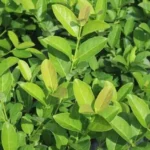Showing 385–396 of 2531 resultsSorted by popularity
-

Burgundy Iceberg Rose STD 90cm
R305.00Add to cartBurgundy Iceberg Rose STD 90cm
Full Sun
Afternoon Sun
Moderate Watering
Monthly Feeding
Prune in WinterStandard roses, also known as lollipop roses, are a form of rose plant that is trained to have a long, straight trunk or stem with a rounded canopy of foliage and flowers at the top.
They are often used as standalone specimens in gardens or as focal points in landscaping.Growth habit
Standard roses are typically grafted plants where a desirable rose variety, known as the “scion,” is grafted onto a tall, straight stem of a different rose species or rootstock.
The stem is trained to grow straight and upright, creating a clear trunk without any side branches until it reaches a specific height.
At the top, the scion forms a rounded head or canopy of foliage and flowers.Height and size
The overall height of standard roses can vary depending on the desired size and how they are pruned.
Generally, standard roses can reach a height of 1 to 2m, with the canopy or head taking up a significant portion of the overall height.Pruning and maintenance
Regular pruning is essential to maintain the shape and size of standard roses. Pruning is typically done in early spring or late winter, before new growth emerges.
It involves removing dead, damaged, or weak wood, as well as shaping the canopy by selectively pruning the side branches.Flowering
Standard roses produce flowers at the top of the canopy, just like other rose varieties.
The flowers can come in various colors, forms, and fragrances, depending on the specific rose variety used as the scion.
They often bloom during the growing season, providing a beautiful display of color and fragrance.Uses
Standard roses are versatile and can be used in different garden settings. They are commonly planted in borders, formal gardens, or as standalone specimens in containers or garden beds.
Due to their vertical stature and the visual impact of the rounded canopy of flowers, they can serve as focal points in landscapes or create a dramatic effect when planted in groups.Varieties
Many rose varieties can be trained as standards, allowing for a wide selection of flower colors, forms, and fragrances.
Popular rose varieties often used as standard roses include hybrid teas, floribundas, and grandifloras.Standard roses, or lollipop roses, are eye-catching additions to gardens and landscapes. Their elegant form, long stems, and rounded canopy of flowers create a unique visual appeal.
With proper care, pruning, and attention, standard roses can bring vertical interest and beauty to any outdoor space. -

Forever Busy Rose STD 90cm
R305.00Add to cartForever Busy Rose STD 90cm
Full Sun
Afternoon Sun
Moderate Watering
Monthly Feeding
Prune in WinterStandard roses, also known as lollipop roses, are a form of rose plant that is trained to have a long, straight trunk or stem with a rounded canopy of foliage and flowers at the top.
They are often used as standalone specimens in gardens or as focal points in landscaping.Growth habit
Standard roses are typically grafted plants where a desirable rose variety, known as the “scion,” is grafted onto a tall, straight stem of a different rose species or rootstock.
The stem is trained to grow straight and upright, creating a clear trunk without any side branches until it reaches a specific height.
At the top, the scion forms a rounded head or canopy of foliage and flowers.Height and size
The overall height of standard roses can vary depending on the desired size and how they are pruned.
Generally, standard roses can reach a height of 1 to 2m, with the canopy or head taking up a significant portion of the overall height.Pruning and maintenance
Regular pruning is essential to maintain the shape and size of standard roses. Pruning is typically done in early spring or late winter, before new growth emerges.
It involves removing dead, damaged, or weak wood, as well as shaping the canopy by selectively pruning the side branches.Flowering
Standard roses produce flowers at the top of the canopy, just like other rose varieties.
The flowers can come in various colors, forms, and fragrances, depending on the specific rose variety used as the scion.
They often bloom during the growing season, providing a beautiful display of color and fragrance.Uses
Standard roses are versatile and can be used in different garden settings. They are commonly planted in borders, formal gardens, or as standalone specimens in containers or garden beds.
Due to their vertical stature and the visual impact of the rounded canopy of flowers, they can serve as focal points in landscapes or create a dramatic effect when planted in groups.Varieties
Many rose varieties can be trained as standards, allowing for a wide selection of flower colors, forms, and fragrances.
Popular rose varieties often used as standard roses include hybrid teas, floribundas, and grandifloras.Standard roses, or lollipop roses, are eye-catching additions to gardens and landscapes. Their elegant form, long stems, and rounded canopy of flowers create a unique visual appeal.
With proper care, pruning, and attention, standard roses can bring vertical interest and beauty to any outdoor space. -
Sale!

Scabiosa White 15cm Pot
Original price was: R110.00.R79.99Current price is: R79.99.Add to cartScabiosa White 15cm Pot
Common Names: CornflowerFull Sun
Afternoon Sun
Wind Tolerant
Low Watering
Evergreen
IndigenousClump-forming perennial that grows up to 30cm and flowers with white flowers almost all year round.
-
Sale!

Agapanthus Bi-Coloured Flower (white with blue) 4lt
Original price was: R95.00.R64.99Current price is: R64.99.Add to cartAgapanthus Bi-Coloured Flower (white with blue) 4lt
-
Sale!

Viburnum Sinensis Standard/Lollipop 10lt
Original price was: R475.00.R359.99Current price is: R359.99.Add to cartViburnum Sinensis Standard/Lollipop 10lt
Viburnum sinensis commonly known as Sweet Viburnum or Chinese Viburnum, is a versatile and hardy shrub that is appreciated for its attractive foliage, fragrant flowers, and ease of care.
Climate and Soil Requirements
Temperature: Thrives in warm, temperate to subtropical climates. Can tolerate light frost but prefers mild winters
Soil: Prefers well-drained, slightly acidic to neutral soils (pH 6.0-7.0). Tolerant of a range of soil types, including sandy, loamy, and clay soils
Sunlight: Requires full sun to partial shade. Best flowering and foliage colour occur in full sunPlanting and Care
Planting Time: Best planted in spring or early autumn
Spacing: Space plants about 2-3 meters apart to allow for adequate growth and air circulation
Watering: Requires moderate watering. Water regularly during dry periods, but allow the soil to dry out slightly between waterings to prevent root rot
Fertilisation: Apply a balanced, slow-release fertiliser in spring. Over-fertilising can lead to excessive foliage growth at the expense of flowers
Pruning: Prune lightly after flowering to maintain shape and encourage bushy growth. Can be pruned more heavily if necessary to control size and shapeFlowering and Foliage
Flowering Season: Blooms in late winter to early spring
Flowers: Clusters of small, white, fragrant flowers that attract pollinators
Foliage: Glossy, dark green leaves that provide an attractive backdrop to the flowers. New growth is often a lighter green.Full Sun
Semi Shade
Low Watering
Wind tolerant
Excellent Hedging plantFull Sun
Semi Shade
Low Watering
Wind tolerant
Excellent Hedging plantViburnum sinensis, commonly known as Sweet Viburnum, is a deciduous shrub found in South Africa. It belongs to the Adoxaceae family and is a favoured ornamental plant due to its beautiful flowers and attractive foliage.
Sweet Viburnum is renowned for its large, striking flower clusters that resemble fluffy, round snowballs, earning it its common name. These flower clusters can reach sizes of 15 to 20cm in diameter and are typically creamy white in colour. They grace the garden with their presence in late spring to early summer, creating a stunning visual display.
The leaves of Viburnum sinensis are oval-shaped, glossy, and dark green. During autumn, they often transition to hues of red or purple, adding to the shrub’s visual appeal. This particular shrub can grow to heights of 6 meters and has a rounded or slightly spreading growth habit.
Viburnum Sinensis thrives in areas with full sun to partial shade in South Africa. It prefers well-draining soil and exhibits tolerance to various soil types, including clay, loam, or sandy soil. Regular watering is necessary during the establishment phase, but once established, it can withstand some drought conditions.
Pruning is typically carried out after the flowering period to maintain the desired shape and remove any dead or damaged branches. This practice can also encourage better flower production for the following year.
Viburnum sinensis is generally a hardy and low-maintenance shrub in South Africa. It exhibits relative resistance to pests and diseases. However, it is recommended to monitor the plant for any signs of issues and take appropriate action if necessary.
Sweet Viburnum is often utilised as a focal point in landscaping, as a hedge, or as part of mixed shrub borders in South Africa. Its large, eye-catching flowers make it a standout in the garden and attract bees and butterflies. Additionally, the flowers can be cut and used in floral arrangements to bring their beauty indoors.
Overall, Viburnum sinensis, is a delightful shrub appreciated for its stunning flower clusters and attractive foliage in South African gardens. Its resilience, low maintenance requirements, and versatility in various garden settings make it a popular choice for adding beauty and charm to outdoor spaces.
-
Sale!

Novelty – Naartjie Tree 6lt
Original price was: R350.00.R199.99Current price is: R199.99.Add to cartNovelty – Naartjie Tree 6lt
-
Sale!

Grapefruit Star Ruby Tree 6lt
Original price was: R350.00.R199.99Current price is: R199.99.Add to cartGrapefruit Star Ruby Tree 6lt
-
Sale!

Lisbon Lemon Tree 6lt
Original price was: R350.00.R199.99Current price is: R199.99.Add to cartLisbon Lemon Tree 6lt
-
Sale!

West Indian Lime Tree 6lt
Original price was: R300.00.R199.99Current price is: R199.99.Add to cartWest Indian Lime Tree 6lt
West Indian lime, also known as Persian lime (Citrus × latifolia), is a popular citrus variety known for its juicy, seedless fruit and tart flavor. While it’s native to the Middle East, it’s widely cultivated in various regions, including South Africa.
Climate and Soil Requirements
Climate: West Indian lime trees thrive in warm, tropical, or subtropical climates. They prefer temperatures between 20°C and 30°C. They can tolerate some cooler conditions but need protection from frost. Suitable regions in South Africa include KwaZulu-Natal, the Eastern Cape, and the Western Cape’s milder coastal areas.
Soil: Lime trees prefer well-draining soil. A sandy loam or loamy soil with good organic content is ideal. Ensure the soil pH is slightly acidic to neutral (around 5.5 to 7.0).Planting and Care
Planting: Choose a sunny spot that gets at least 6-8 hours of sunlight daily.
Dig a hole twice the size of the root ball.
Place the tree in the hole, ensuring the top of the root ball is level with the surrounding soil.
Backfill with soil, water thoroughly, and mulch around the base to retain moisture and suppress weeds.
Watering: Lime trees need regular watering, especially during the establishment phase. Keep the soil consistently moist but not waterlogged. Water deeply once or twice a week, more often in hot, dry periods.
Fertilising: Feed the tree with a balanced citrus fertiliser during the growing season (spring to autumn). Supplement with micronutrients like iron and magnesium if needed.
Pruning: Prune the tree to maintain its shape, remove dead or diseased branches, and improve air circulation. Pruning after the harvest season is ideal.Harvesting
Leaves: Lime leaves can be harvested year-round. Pick mature leaves as needed for culinary use. New leaves are more tender and aromatic.
Fruit: The fruit typically matures in late autumn to winter. Kaffir limes are small, green, and have a bumpy rind. They can be used fresh or dried.Growing in Pots
If you have limited space or live in an area with unsuitable climate conditions, growing West Indian limes in pots is a viable option. Use a large pot with good drainage holes and high-quality potting mix. Ensure the tree gets adequate sunlight and is protected from extreme weather.
Tips for Success
Frost Protection: In regions with occasional frost, cover the tree with frost cloth or bring potted trees indoors during cold spells.
Mulching: Mulch around the base of the tree to retain soil moisture, regulate temperature, and reduce weed competition.
Pollination: Lime trees are self-pollinating, but having multiple trees can increase fruit set. -
Sale!

Philodendron Green Emerald 20cm Pot
Original price was: R275.00.R174.99Current price is: R174.99.Add to cartPhilodendron Green Emerald 20cm Pot
Philodendron Green Emerald is a specific cultivar of Philodendron, characterized by its glossy, deep green leaves and compact growth habit.
Light
Provide bright, indirect light for your Philodendron Green Emerald. While it can tolerate lower light conditions, it thrives in moderate to bright indirect sunlight. Avoid direct sunlight, as it can scorch the leaves.Watering
Allow the top inch or two of the soil to dry out between waterings. Philodendrons prefer slightly moist soil but can be susceptible to root rot if overwatered. Ensure proper drainage in the pot to prevent waterlogging.Temperature
Keep your Philodendron Green Emerald in a warm environment with temperatures between 18°C to 27°C. Avoid exposing it to cold drafts or sudden temperature changes.Humidity
Philodendrons enjoy moderate to high humidity levels. If the air in your home is dry, you can increase humidity by misting the leaves, using a humidifier, or placing the plant on a pebble tray filled with water.Soil
Plant your Philodendron Green Emerald in well-draining potting soil. A mix formulated for tropical plants or a blend of peat moss, perlite, and coarse sand works well.Fertilisation
Feed your Philodendron Green Emerald with a balanced liquid fertiliser diluted to half strength every 4-6 weeks during the growing season (spring and summer). Reduce or stop fertilising in the fall and winter when growth slows down.Pruning
Regularly remove any yellowing or damaged leaves to promote healthy growth. You can also prune to shape the plant or control its size if it becomes too large. -
Sale!

Protea Sylvia 15cm Pot
Original price was: R350.00.R179.99Current price is: R179.99.Add to cartProtea Sylvia 15cm Pot
Full Sun
Afternoon Sun
Low Watering Once Established
Drought Tolerant
Indigenous
Evergreen -
Sale!

Protea Niobe 15cm Pot
Original price was: R350.00.R179.99Current price is: R179.99.Add to cartProtea Niobe 15cm Pot
Full Sun
Afternoon Sun
Low Watering Once Established
Drought Tolerant
Indigenous
Evergreen
